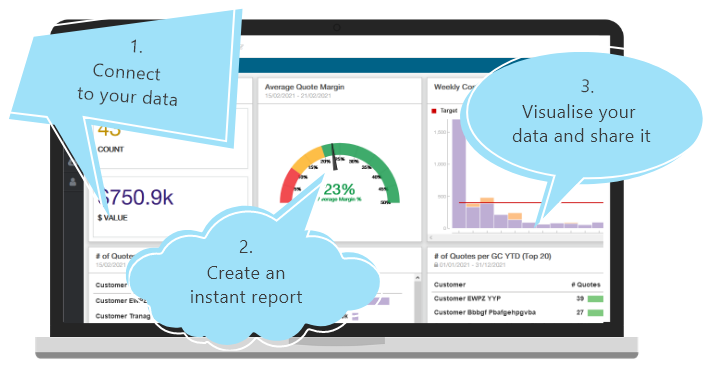How to set up dynamic pricing and automate your ServiceTitan Pricebook
The cost of equipment and materials going up and down is problematic when those changes don’t reflect in your pricebook immediately. That's the last thing you should be worrying about.
A technician is out on a service call, diagnosing a customer’s problem. They consult ServiceTitan Mobile on their tablet to find the materials and equipment they’ll need for the service. They add those items to an estimate and present it to the customer.
Back at the office, they discover the pricing they used was, in fact, outdated. Maybe some overhead costs have changed, or there’s been a supplier price increase or a discount decrease - whatever it is, it impacts your profit margin. Now what?
Of course you want to avoid this sort of thing from happening. It doesn’t help that the data in your pricebook is essentially static. So, you decide to use ServiceTitan’s dynamic pricing and automate it!
We guide you through the setup of dynamic pricing in ServiceTitan, the extent to which it can automate your pricebook, and a rather simple alternative.
How does dynamic pricing in ServiceTitan work?
At first glance, it’s a step-up from the old ways of updating the ServiceTitan Pricebook. Back in the day, you had to activate the pricing wizard each time you wanted to process any updates. Before that, in the dark days of printed brochures, you’d have to dream about price accuracy and hope for the best. Thankfully, those days are over.
Yet, a manual component stuck around like a bad smell. The pricing wizard was inflexible and suffered from amnesia, unable to remember your settings and formulas. ServiceTitan offered up dynamic pricing as an improvement on the wizard.
Setting up dynamic pricing rules
- Access Pricing Builder in your Pricebook menu.
- Select the Dynamic Pricing tab to focus on sold hours.
- Create your pricing rules and under ‘Categories’, get as detailed as you like with your ServiceTitan Pricebook items, keeping in mind that items within a category might require different markup structures.
- Enter your billable rate (per sold hour) for the selected categories - choose between assigning a flat rate per hour or a progressive rate, which determines the cost per hour based on the number of hours a task takes.
- Move onto the markup stage for materials and equipment linked to services. Mark them up by gross margin, percentage, flat dollar amount, or by multiplier number.
- Repeat the exercise for your equipment markups or use the same rules as for materials.
- The next step in the process is optional where you can add a surcharge flat amount or percentage. Or skip this step.
- Finally, get an overview of the dynamic pricing rules you’ve set up, and check them carefully. As you know, where human hands fiddle, errors like to creep up and wreak havoc.
- Use the options to modify pricing rules for a service as an add-on, when performed after hours, or adjust price levels according to the level of difficulty of a task.
- Give your rule a unique name and description.
Dynamic pricing in action
Once set up, any time anyone in your team creates an estimate or quote, adding services with rules applied to them should automatically reflect the correct pricing.
Here’s a big NB: the rule remains consistent even when pricing items change. For the rule to calculate the correct costing for a quote, unit costs must be monitored and checked for accuracy.
The cost of a material item or equipment can increase all it wants. As long as you have someone watching those update notifications in your ServiceTitan Pricebook and making the necessary changes as they happen (as quickly as possible), you'll be able to churn out estimates correctly based on your pricing rules.
So, applying rules to future quotes and estimates is what makes your pricing dynamic. As far as actually updating pricing data within the system, it’s possible but limited. It comes courtesy of material costs taken from your supplier billing.
That's one way to update a pricebook...
When you send off a purchase order (PO), it lists your items on order together with the quantity and unit costs. ServiceTitan's workaround requires you to grab the correct costs to add to your Pricebook.
Your accounts payable guy will know that you need the Purchasing tab turned on for your ServiceTitan account. From there, you access the PO sent to a supplier and use it to verify that it matches the order received - most importantly for the purpose of this exercise, the unit costs. Use these to create a Vendor Bill.
ServiceTitan automatically creates vendor bills - that action is selected by default. Only problem is, it creates a carbon copy of your original PO. That’s no good to you.
We’ll repeat the annoying truth. You must check that what the supplier has actually charged you for the goods you ordered matches up with the pricing in your system. With the auto-generated Vendor Bill simply mimicking the info on your PO, obviously zero updates will be found. The trick only works if you create your own manually.
A pricing update workaround
Navigate to the Receipts tab under your Purchasing menu, click on the receipt number for the bill received from the supplier. Select the action to (re)create Bill. A list of items will appear where you can see the unit costs the supplier has charged you.
If anything differs from the info you have in your Pricebook, check with the supplier if all is correct or the reason for the price change. Once verified, you, your admin person or the accounts payable guy can then manually adjust the unit cost in the provided field.
Toggle that Update Pricebook button.
A pricebook automated in parts
A bit like the bridesmaid of real-time updates (and never the bride), what you’ll have is an update of the most current pricing for a select group of materials.
The updated unit costs will now be available in your ServiceTitan Pricebook. That’s a fine albeit fiddly way of doing it and could work out if you’re able to detect all price changes on your manually created Vendor bills off PO's. If not, the rest of your Pricebook items will still have to be updated the way you’ve always done them: manually.
Also, it does nothing for items that suppliers have newly added to their inventory - the ones that aren’t on any of your PO's.
But you’ll be fine unless the industry is especially volatile and things change dramatically during the gap between updates and new quotes… That’s your worst case scenario.
Still holding out for truly dynamic, automated pricing?
We don’t blame you. Your business not only needs it for greater efficiency among your techs, but also for profitability. Nothing is more empowering on both accounts than real-time updates.
You’re using a great system in ServiceTitan to run your home service business. And maybe you’ve upgraded to the Pro package to take advantage of features like Pricebook Connect.
Maybe you use one of their supplier catalog integrations (provided your supplier has bought into the idea as it would cost them, and they’d have to customize their system to talk to ServiceTitan). At least you’d get notified of any new content, like new items on a supplier catalog or upgrade and recommendation updates to services you sell.
The bottom line is you still end up changing a lot of your pricing manually. If that doesn’t sound like your cuppa’ jo, then read all the way to the end of this article.
What a truly dynamic pricebook looks like
Wink partners with ServiceTitan to help users optimize their pricebooks. It’s true, a pricebook is never really ‘finished’ but there's no reason for all the fiddling.
Checking supplier catalogs, waiting and watching for change notifications to pop up in the system, processing changes and adding new price items manually - these are neither efficient nor optimal use of your ServiceTitan Pricebook. While you can do nothing about prices going up and down in real time, there is a tool that can update your pricing in real time.
With your ServiceTitan account connected to Wink Reports, our software automates your Pricebook updates.
- First you connect, then we manage the integration with your supplier via their API.
- We detect when there’s new content to add to your pricebook, and automatically update it.
- It keeps your pricing data correct and available at all times.
Ready to transform the bridesmaid into an instant bride? Sign up to Wink and get set up for automated pricing your business can trust.

%20(1)-1.png?width=900&height=450&name=Hubspot%20Blog%20Header%20Banner_1%20(900%20x%20450%20px)%20(1)-1.png)



